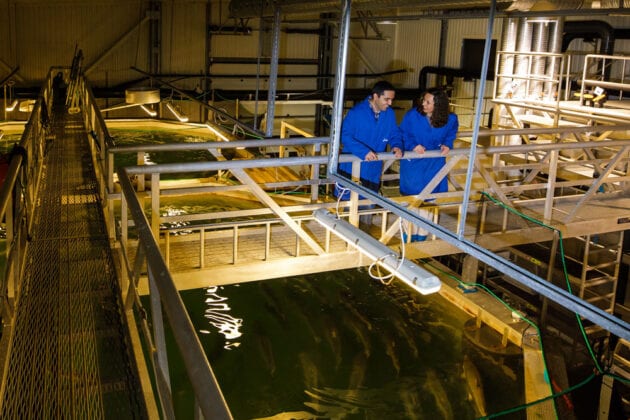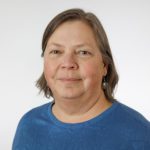Nofima Centre for Recirculation in Aquaculture

Recirculation of water provides extremely good control of the water environment, sensible utilisation of water sources and better protection against infection.
The Nofima Centre for Recirculation in Aquaculture carries out research on recirculation in aquaculture on a broad basis.
Experiments in the areas of nutrition, physiology and fish welfare is central along with research on recirculation technology. Operation of recirculating aquaculture systems (RAS) must be adapted for salmon so that fish welfare is taken care of and the fish shows optimal growth and feed utilisation. In addition, operation of the system must be well integrated with the rest of the supply chain so that the capacity of the RAS is exploited to the maximum.
The centre is continuously modified to enable experiments to be carried out on the fish’s growth and welfare, as well as on future RAS-related issues. Consequently, the system is of a flexible nature to enable the technology to be exchanged or modified.
Film
Watch a film about research on RAS in Nofima.
Equipment and methods
The research plant will be ideal for testing out equipment, methods and operational routines in collaboration with the industry. Nofima wants to contribute to developing competence in this field for the industry and society in general.
Access to freshwater and seawater
The Nofima Centre for Recirculation in Aquaculture is unique in Norway as the only research facility of approximate commercial size (1750 m²). The centre features six experimental sections and has a total breeding volume of 1100 m³. The centre has access to both freshwater and seawater.
Various water qualities
Two experimental sections contain 15 separate 2 m tanks each and one section has 18 1 m tanks. During experiments all 48 tanks may use one of two separate recirculating systems (RAS 1 and RAS 2) or three other water qualities in flow-through mode. Further, three sections are being constructed with three 100 m³ tanks in each for experiments on a larger scale. Two of these sections have separate recirculating, while one section is operated with flow-through.
Four recirculating systems
The centre currently has four totally separate recirculating systems. Each of these contains side and centre outlets in the tanks, particle collectors at tank level, ozone treatment, micro sieves, moving bed biofilters/bioreactors each with three chambers, counter current CO2 degassers, sump and oxygen treatment.
The RAS in the large hall have a maximum flow capacity of 12 m³/min, while the smaller RAS each have a capacity of 2.3 m³/min. The systems have an interface for remote water heating (+80°C) to heat process water and buildings.
Cooling water is added from the power station. The centre is controlled by several programmable logic controllers (PLCs). This enables the continual logging of research data, including pump status, water flow, temperature, oxygen, pH and oxidisation-reduction potential (ORP). The centre also has an auto analyser for rapid and accurate measurement of ammonia, nitrite, nitrate and CO2.
The building is purpose-built for the research infrastructure with several entrances, submerged areas and culverts for easy access to pipe trenches. The centre has a central viewing area on other levels, which enables visitors to get an overview without crossing the hygiene barrier. In addition, the first floor has a 200 m² area for moving, sorting and sampling the experimental fish. Each of the six experimental plants and the water treatment room have sluices for contamination control. There are a total of five ventilation plants, including a separate plant for heating or cooling of the intake air to the CO2 degassers for all four RAS. In cases where infection is suspected, the ventilation plant may be shut off for individual rooms.
Ownership
Sjølseng Eiendom AS owns the actual building, while Nofima owns the infrastructure associated with the research activities. Sunndal Aktivum, Sunndal Municipal Council and Møre og Romsdal County Council have been important contributors to the realisation of the centre.
Idea and concept
Nofima had the idea, concept and overall project management during the preliminary work and construction. The work involved requirements for flexibility, water quality and capacity. Important contributions were also made by research communities here in Norway and abroad.
Questions and enquiries
Adress
Nofima
Sjølseng
NO-6600 Sunndalsøra
